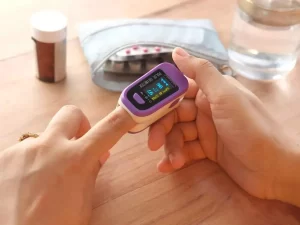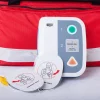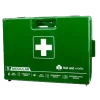
Recent Post
 Could You Recognise the Signs That Someone Needs a Defibrillator?
Could You Recognise the Signs That Someone Needs a Defibrillator?
September 12, 2023
Every australian home needs a finger pulse oximeter for monitoring health conditions. A finger pulse oximeter is a device that measures the level of oxygen in your blood and is a must-have device for every australian household, especially in the current times of the covid-19 pandemic.
The device is small, portable, and easy to use. It can provide early warning signs for a range of respiratory issues and helps diagnose underlying health conditions. With a finger pulse oximeter, one can quickly measure their oxygen saturation levels and detect any potential health problems.
It is particularly useful for people with asthma, copd, sleep apnea, or any other respiratory disorders. Moreover, it is an essential device for athletes and mountain climbers who need to monitor their oxygen levels in high-altitude conditions. Therefore, investing in a finger pulse oximeter is an excellent way to safeguard your health, and every australian home needs one.
Credit: m.economictimes.com
Understanding Finger Pulse Oximeters: What Are They And How Do They Work?
Finger pulse oximeters have become increasingly popular in australia and across the globe, so it’s important to understand what they are and how they work. This blog post will provide valuable insights into finger pulse oximeters and why every australian home needs one.
Definition Of Finger Pulse Oximeters
Finger pulse oximeters are non-invasive devices that measure the oxygen saturation level (spo2) in your blood. They work by emitting small beams of light through your fingertip and measuring how much light is absorbed by the blood. The device will also measure your pulse rate, which is the number of times your heart beats in one minute.
- Finger pulse oximeters are small and portable, making them convenient to use at home.
- They are widely available and relatively inexpensive, so you can easily purchase one online or from a medical supply store.
- Finger pulse oximeters are easy to use and provide accurate and reliable readings.
How Finger Pulse Oximeters Measure Oxygen Saturation Levels
As previously mentioned, finger pulse oximeters use a non-invasive method to measure blood oxygen levels. The device contains a small light-emitting diode (led) that emits light of two different wavelengths, usually red and infrared light. The light passes through the fingertip, and a photodetector on the other side absorbs the light.
The amount of light absorbed by the blood varies depending on the oxygen saturation level. Oxygenated blood absorbs more infrared light and allows more red light to pass through, while deoxygenated blood absorbs more red light and allows more infrared light to pass through.
The device calculates the ratio of red light to infrared light to determine the oxygen saturation level in your blood.
- Finger pulse oximeters are non-invasive and painless. You don’t need to prick your finger or draw blood to use them.
- They provide instant readings, and you can easily check your oxygen saturation level and pulse rate in real-time.
- Some finger pulse oximeters have additional features, such as a graph that shows your oxygen saturation level over time or an alarm that alerts you when your oxygen levels drop too low.
Importance Of Measuring Blood Oxygen Levels
Measuring blood oxygen levels is crucial for monitoring your overall health and well-being. Low blood oxygen levels, also known as hypoxemia, can lead to serious health complications, such as respiratory failure, organ damage, or even death.
- Finger pulse oximeters can detect low blood oxygen levels early, allowing you to take action before any serious complications occur.
- People with chronic respiratory diseases, such as asthma or copd, can benefit from using finger pulse oximeters to monitor their oxygen levels regularly.
- Using finger pulse oximeters can give you peace of mind, especially during times when respiratory illnesses are rampant.
Overall, finger pulse oximeters are affordable devices that provide valuable insights into your health. Investing in one for your home can help you stay on top of your health and detect any potential health complications early.
Why Every Australian Home Needs A Finger Pulse Oximeter
It’s essential to prioritise our health in this fast-paced world. With the growing levels of pollution and changing weather conditions, it’s crucial to keep a close eye on our health. One such device that can help us monitor our health at home is a finger pulse oximeter.
In this post, we’ll discuss why every australian home needs a finger pulse oximeter.
The Impact Of Air Pollution On Breathing And Oxygen Saturation Levels
Air pollution is a growing concern in australia, with many cities experiencing high levels of pollution. Breathing polluted air can lead to reduced oxygen saturation levels in the body, leading to severe health issues. Here are a few key points to keep in mind:
- Air pollution can trigger respiratory illnesses, aggravate asthma, and increase the risk of lung cancer.
- It can cause coughing, wheezing, and shortness of breath, leading to reduced oxygen saturation levels.
- Finger pulse oximeters can help track oxygen levels and alert users to seek medical attention if levels fall below normal.
The Importance Of Early Detection And Prevention Of Respiratory Illnesses
Respiratory illnesses are becoming more common in australia, especially during the flu season. It’s essential to detect respiratory illnesses early to prevent them from spiralling into severe health issues. Here are a few key points to keep in mind:
- Early detection can help start treatment early and prevent the illness from progressing.
- Finger pulse oximeters can help monitor oxygen saturation levels and detect early signs of respiratory illnesses.
- Regular monitoring can also help detect the effectiveness of treatment and ensure a speedy recovery.
Hidden Risks Of Sleep Apnea And Cardiac Arrest
Sleep apnea and cardiac arrest are two significant health risks that often go undetected until a severe event occurs. However, with the use of finger pulse oximeters, these risks can be detected early. Here are a few key points to keep in mind:
- Sleep apnea can cause reduced oxygen saturation levels, leading to severe health issues.
- Finger pulse oximeters can help monitor oxygen saturation levels during sleep and detect signs of sleep apnea.
- Cardiac arrest can also cause a sudden drop in oxygen saturation levels, making pre-emptive detection crucial.
Affordable And Accessible Home Monitoring For Everyone
One of the best things about finger pulse oximeters is that they’re affordable and accessible to everyone. Here are a few key points to keep in mind:
- Finger pulse oximeters are affordable and can be purchased by anyone looking to monitor their health at home.
- They’re easy to use and don’t require any medical expertise.
- They provide an accurate reading of oxygen saturation levels, making them a reliable tool for home monitoring.
Finger pulse oximeters are an essential tool for home monitoring, especially in Australia, where pollution and respiratory illnesses are becoming increasingly common. By using a finger pulse oximeter, we can monitor our health at home, detect early signs of respiratory illnesses, and reduce the risk of severe health issues.
Key Features Of Finger Pulse Oximeters To Consider Before Buying
Why Every Australian Home Needs A Finger Pulse Oximeter
Finger pulse oximeters are essential medical gadgets that every australian home requires. These devices measure the amount of oxygen in your blood and monitor your heart rate through a non-invasive method using a fingertip sensor. These gadgets are vital for people with respiratory problems, heart diseases, and covid-19 patients.
They are simple to operate, portable, and offer real-time results, allowing users to monitor their health from the comfort of their homes.
Accuracy And Reliability Of Pulse Oximetry Readings
Before buying a finger pulse oximeter, you must consider its accuracy and reliability of pulse oximetry readings. Here are some key points to keep in mind:
- Look for a device that has a +/- 2% accuracy range.
- Choose a gadget that provides real-time monitoring of your oxygen saturation level and heart rate.
- Check for fda approval to ensure safety and efficiency.
- Calibrated devices provide more accurate results.
Measurement Range And Display Capabilities
The measurement range and display capabilities are essential features to consider when investing in a finger pulse oximeter. Here are some crucial points to keep in mind:
- Find a device with a wide measurement range that can support both children and adults.
- Display should be user-friendly, with a clear and colorful oled screen.
- The display should provide a clear view, even in low light environments.
- Large, easy-to-read numbers ensure convenience and a better user interface.
Durability And Comfort Of Design
The durability and comfort of the design are necessary to ensure that you can use the finger pulse oximeter for extended periods. Here are some key considerations to keep in mind:
- Look for a durable and robust design featuring robust materials such as silicone.
- Choose a device that fits all finger sizes and has a comfortable fit.
- Consider the device’s weight, as it should be comfortable to wear and carry around.
- Anti-slip exterior material ensures the gadget does not slip from your fingertip.
Battery Life And Cost-Effectiveness
Battery life and cost-effectiveness are crucial factors to consider when investing in a finger pulse oximeter. Here are some essential points to keep in mind:
- Long battery life is necessary to ensure you do not frequently change your gadget’s batteries.
- Look for energy-saving features such as automatic power-off and low battery indicators.
- A cost-effective device provides a valuable investment, ensuring you get quality for your money.
Additional Features And Functions
Finally, when investing in a finger pulse oximeter, consider additional features and functions that add value to the gadget. Here are some key considerations to keep in mind:
- Some gadgets have a built-in alarm that signals when your oxygen saturation level is low or your heartbeat is irregular.
- Some devices have bluetooth connectivity, allowing you to transfer data to your smartphone for easy tracking.
- A gadget that stores your previous readings in its memory makes it easier to monitor your health changes.
- Some devices come with attachments or lanyards to ensure you can carry the gadget around with ease.
How To Use And Interpret Finger Pulse Oximeter Readings
Why Every Australian Home Needs A Finger Pulse Oximeter
If you are not familiar with a finger pulse oximeter, it’s time to know about this medical device that can save lives. A finger pulse oximeter is a small and portable device used to measure blood oxygen saturation levels, which is vital information for people with respiratory problems.
More than ever, it is necessary to have one in every australian home, especially during the covid-19 pandemic when respiratory illness is a significant concern.
Step-By-Step Guide To Measuring Blood Oxygen Saturation Levels
Using a finger pulse oximeter at home is a simple and non-invasive way of measuring blood oxygen saturation levels. Here is a step-by-step guide:
- Switch on the finger pulse oximeter.
- Place the device on your fingertip, preferably the index finger, making sure the device’s sensor covers your nail bed.
- Wait for a few seconds until the device’s sensor reads your pulse rate and oxygen saturation levels.
- After a few seconds, the device will display your oxygen saturation levels in percentage.
What Is A Normal Oxygen Saturation Level And When To Seek Medical Attention
A healthy individual should have an oxygen saturation level of 95% to 100%. Anything less than 90% is considered low and may indicate an underlying respiratory problem or a medical emergency. If your finger pulse oximeter reading falls below 90%, seek medical attention immediately.
Common Misconceptions And Myths About Pulse Oximetry Readings
Several myths surround pulse oximetry readings, leading to confusion and misinformation. Here are some common misconceptions and the truth behind them:
- Myth: A low pulse oximeter reading indicates low oxygen levels in the body.
Truth: a low pulse oximeter reading means low oxygen saturation in the blood, not necessarily the body. It can be due to various factors like poor blood circulation, anemia, or chronic obstructive pulmonary disease.
- Myth: A high pulse oximeter reading is excellent and means more oxygen in your body.
Truth: a high pulse oximeter reading is not necessarily a good thing. It can indicate that a person is compensating for low oxygen levels due to a respiratory problem, which requires immediate medical attention.
- Myth: Finger pulse oximeters are inaccurate and unreliable.
Truth: finger pulse oximeters are accurate and reliable if used correctly. Their readings can provide essential information about a person’s respiratory health and help diagnose any underlying conditions.
Owning a finger pulse oximeter is necessary, especially if you have respiratory problems or live with someone who does. It can help you monitor your oxygen saturation levels and take necessary precautions in case of any medical emergency.
Tips For Maintaining And Caring For Finger Pulse Oximeters
Why Every Australian Home Needs A Finger Pulse Oximeter
Are you concerned about your health, especially when it comes to your respiratory system? If so, then a finger pulse oximeter is an essential device to have in every australian home. With its easy-to-use nature, it allows anyone to monitor their blood oxygen levels at any time.
But, using and owning a finger pulse oximeter is not enough. Proper cleaning, disinfecting, storage, and handling are essential to ensure its accuracy and longevity. Here are some tips that you can follow for maintaining and caring for your finger pulse oximeter.
Proper Cleaning And Disinfecting Techniques
Keeping your finger pulse oximeter clean and disinfected is crucial, especially during these times of a pandemic. Here’s how to do it correctly:
- Begin by wiping the device with a clean, soft, and damp cloth to remove dirt and dust particles.
- Use a microfiber cloth to dry the device completely.
- Using a disinfectant wipe, clean the surface of the device and let it air-dry.
- Perform this cleaning routine after each use or at least once a day.
Recommended Storage And Handling Practices
Proper storage and handling are essential to keep your finger pulse oximeter functioning and accurate. Here are some recommended tips:
- Store your device in a cool, dry place and away from sunlight.
- Avoid exposing the device to extreme temperatures, moisture, or direct sunlight.
- Use the device as per instructions and avoid any unnecessary force or exertion.
- Always use the device on clean fingers to maintain its accuracy.
- If not in use, store the device in a protective case.
Troubleshooting And Maintenance Tips
Despite proper cleaning and handling, your finger pulse oximeter may sometimes give inaccurate readings or encounter technical issues. In such a scenario, follow these tips:
- Check the battery of the device and change it if it’s low.
- Read the instruction manual and follow the troubleshooting guide.
- Contact the manufacturer’s customer service or technical support team if the device still doesn’t work.
- Regularly check the device for damage or wear and tear.
A finger pulse oximeter is essential for every australian home, especially during these times of a pandemic. Proper maintenance, handling, cleaning, and disinfecting are essential to ensure your device functions accurately and lasts longer. Follow these tips to care for your finger pulse oximeter, and stay on top of your health by monitoring your blood oxygen levels at any time.
Frequently Asked Questions On Why Every Australian Home Needs A Finger Pulse Oximeter
What Is A Finger Pulse Oximeter?
A finger pulse oximeter is a medical device that measures oxygen saturation levels in your blood. It works by shining a light through your fingertip and detecting the amount of oxygen in your blood.
How Accurate Are Finger Pulse Oximeters?
Finger pulse oximeters are generally very accurate, with a range of error of about 2%. However, factors such as skin color, nail polish, and cold fingers can affect the accuracy of the readings.
Why Do I Need A Finger Pulse Oximeter At Home?
A finger pulse oximeter is a useful tool to have at home to monitor your oxygen saturation levels. It can be especially important if you have a pre-existing condition that affects your respiratory system or if you are recovering from an illness.
Who Can Benefit From Using A Finger Pulse Oximeter At Home?
Anyone can benefit from using a finger pulse oximeter at home, especially seniors, people with respiratory conditions such as copd or asthma, and athletes who want to monitor their oxygen levels during workouts.
How Do I Use A Finger Pulse Oximeter?
Using a finger pulse oximeter is simple. Just turn it on, slip it onto your fingertip, wait for the reading to stabilise, and read the oxygen saturation level on the display. It’s important to follow the manufacturer’s instructions for best results.
Are Finger Pulse Oximeters Safe To Use At Home?
Yes, finger pulse oximeters are safe to use at home. They are non-invasive and pose no risk to your health. However, it’s important to always follow the manufacturer’s instructions and consult your doctor if you have any concerns about your health.
Conclusion
Having a finger pulse oximeter in your home is a small yet significant investment, especially in today’s unprecedented times. It empowers you to monitor your oxygen saturation level, and keep track of any fluctuations before they turn into a major concern that requires urgent medical attention.
A finger pulse oximeter comes in handy for all individuals, including those living with chronic medical conditions, athletes, and those who suffer from breathing problems. It accurately records data and provides alerts in real-time, ensuring timely intervention. Not only does it help avoid discomfort and stress, but it also gives you peace of mind.
Therefore, it is an indispensable tool that every australian home must have. So, don’t hesitate to invest in a finger pulse oximeter. It could mean the difference between a minor health issue and a major medical emergency.






